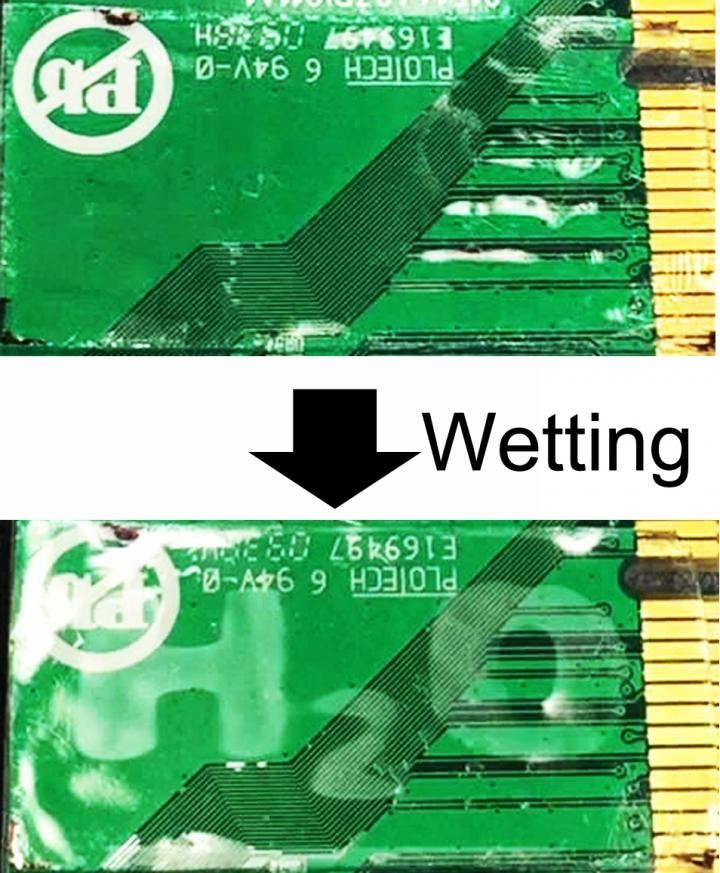Aug 22 2016
 A coating on a circuit board is unobservable when dry (top) but wrinkles to display 'H2O' when exposed to moisture (bottom). (CREDIT: Songshan Zeng)
A coating on a circuit board is unobservable when dry (top) but wrinkles to display 'H2O' when exposed to moisture (bottom). (CREDIT: Songshan Zeng)
Jellyfish skin, squid skin and human skin, have inspired a team of chemists to create materials that change texture or color as response to changes in their surroundings. They suggest that these materials will help to develop anti-glare surfaces, detect damage or moisture, or even encrypt secret messages.
This research work was presented on 21 Aug, 2016, at the 252nd National Meeting & Exposition, hosted by the world's largest scientific society, the American Chemical Society (ACS). Over 9,000 presentations on various science topics were featured at this meeting.
Our experimental materials use cracks, folds or wrinkles to mimic the surface engineering of skin. These new materials are unique because they change color or transparency when they're stretched or exposed to moisture.
Luyi Sun, Ph.D., University of Connecticut
Sun's graduate student Songshan Zeng stated that, just like how human fingers wrinkle when they are submerged in water for a long time, jellyfish skin can also wrinkle. "When they're scared, some types of jellyfish form a wrinkled surface that is opaque and warns off predators," says Zeng, who has a leading role in the project. "That same surface is transparent when it's flat.”
Something even more admirable about a squid’s reaction when it is startled is that the muscles in its skin contract and expose colored pigments which act as camouflage.
At the University of Connecticut, Sun's team along with Dianyun Zhang, Ph.D., studied the three types of skin to analyze the engineering alterations they underwent when exposed to various environmental changes. The wrinkled surfaces were replicated by the researchers by keeping a rigid thin film of polyvinyl alcohol on a rubbery base of polydimethylsiloxane (PDMS).
Like finger skin, whenever part of the film is exposed to moisture, it swells slightly, generating wrinkles.
Luyi Sun, Ph.D., University of Connecticut
As the wrinkled part of the film is opaque, it can be used to make patterns (e.g. letters), which are visible only when the film is moistened.
Sun is proud about the fact that his team is one of very few involved in studying the dynamics of moisture-induced wrinkles. They are also studying how long these wrinkles exist and also are finding ways to reverse them.
In the thin film, the existence and degree of crosslinking amongst polymer chains determines if the wrinkling is reversible or not. However, when the film is formulated without crosslinking, moisture can be used to generate wrinkles and later the wrinkles can be slowly smoothed out, and the wrinkles cannot form again.
Zeng explained that this feature can be used in cases where the message needs to be displayed once, and then to permanently erased.
Additionally, if a certain type of crosslinking is present in the film, the wrinkles that are generated by moisture will never be erased.
A small label that incorporates this technology can be fixed inside any circuit board or cell phone.
If the phone falls into a toilet, permanent wrinkles of desired shapes will be formed on the label; in this situation it will display the chemical formula for water (H2O). This will help the vendor identify that the customer has void the warranty.
As these wrinkles can scatter light rays in multiple directions, instead of directly reflecting them at a viewer, researchers are trying to use this property of wrinkled materials for another cell phone application. A different formulation of this material will help researchers to produce an effective and cheap anti-glare screen for phones.
In another project, Sun and his team mimicked squid skin by developing a PDMS base layer comprising a limited amount of fluorescent dye. They used a rigid thin film of polyvinyl alcohol/clay composite to coat it. The surface layer is prone to many small cracks and folds because of the presence of clay.
If the material is stretched, the folds and cracks open on the originally smooth surface, thus modifying its appearance and topography. Based on its formulation, the film will be able to go from clear to opaque, or even be able to reversibly change color and luminescence.
One of the potential applications of this material is a smart window comprising a clear material that becomes opaque when slightly stretched to provide privacy. Sun says that this team is the first to have been involved in making such materials.